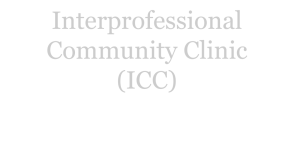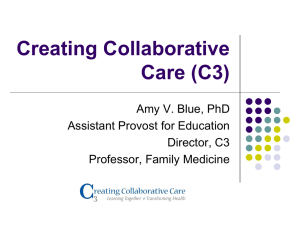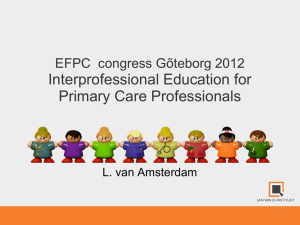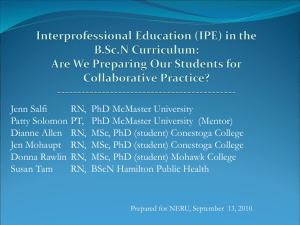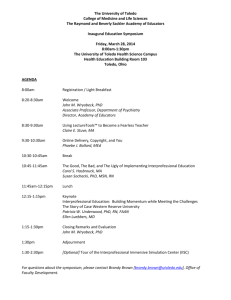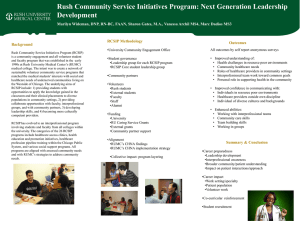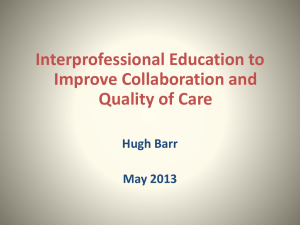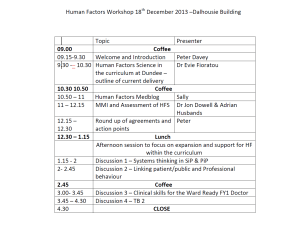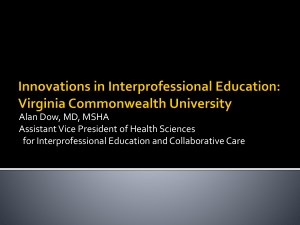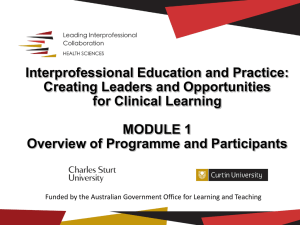Developing Student Interprofessional Team Communication
advertisement
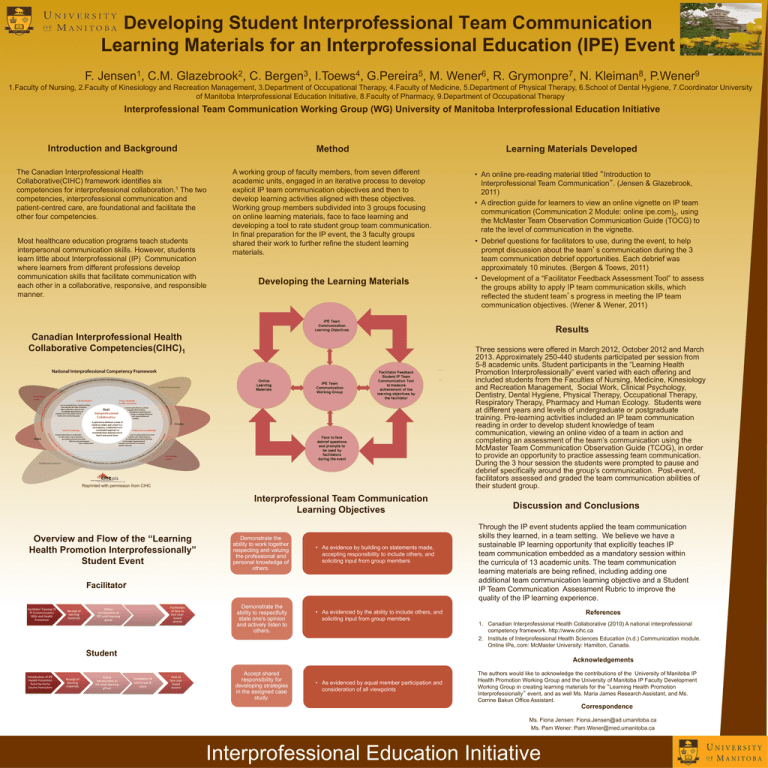
Developing Student Interprofessional Team Communication Learning Materials for an Interprofessional Education (IPE) Event F. 1 Jensen , C.M. 2 Glazebrook , C. 3 Bergen , 4 I.Toews , 5 G.Pereira , M. 6 Wener , R. 7 Grymonpre , N. 8 Kleiman , 9 P.Wener 1.Faculty of Nursing, 2.Faculty of Kinesiology and Recreation Management, 3.Department of Occupational Therapy, 4.Faculty of Medicine, 5.Department of Physical Therapy, 6.School of Dental Hygiene, 7.Coordinator University of Manitoba Interprofessional Education Initiative, 8.Faculty of Pharmacy, 9.Department of Occupational Therapy Interprofessional Team Communication Working Group (WG) University of Manitoba Interprofessional Education Initiative Introduction and Background Method The Canadian Interprofessional Health Collaborative(CIHC) framework identifies six competencies for interprofessional collaboration.1 The two competencies, interprofessional communication and patient-centred care, are foundational and facilitate the other four competencies. A working group of faculty members, from seven different academic units, engaged in an iterative process to develop explicit IP team communication objectives and then to develop learning activities aligned with these objectives. Working group members subdivided into 3 groups focusing on online learning materials, face to face learning and developing a tool to rate student group team communication. In final preparation for the IP event, the 3 faculty groups shared their work to further refine the student learning materials. Most healthcare education programs teach students interpersonal communication skills. However, students learn little about Interprofessional (IP) Communication where learners from different professions develop communication skills that facilitate communication with each other in a collaborative, responsive, and responsible manner. Developing the Learning Materials Interprofessional Team Communication Learning Objectives Demonstrate the ability to work together respecting and valuing the professional and personal knowledge of others. • As evidence by building on statements made, accepting responsibility to include others, and soliciting input from group members Facilitator Receipt of learning materials Facilitation of face-to face casebased session Online introductions to IPE small learning group • Debrief questions for facilitators to use, during the event, to help prompt discussion about the team’s communication during the 3 team communication debrief opportunities. Each debrief was approximately 10 minutes. (Bergen & Toews, 2011) • Development of a “Facilitator Feedback Assessment Tool” to assess the groups ability to apply IP team communication skills, which reflected the student team’s progress in meeting the IP team communication objectives. (Wener & Wener, 2011) Three sessions were offered in March 2012, October 2012 and March 2013. Approximately 250-440 students participated per session from 5-8 academic units. Student participants in the “Learning Health Promotion Interprofessionally” event varied with each offering and included students from the Faculties of Nursing, Medicine, Kinesiology and Recreation Management, Social Work, Clinical Psychology, Dentistry, Dental Hygiene, Physical Therapy, Occupational Therapy, Respiratory Therapy, Pharmacy and Human Ecology. Students were at different years and levels of undergraduate or postgraduate training. Pre-learning activities included an IP team communication reading in order to develop student knowledge of team communication, viewing an online video of a team in action and completing an assessment of the team’s communication using the McMaster Team Communication Observation Guide (TCOG), in order to provide an opportunity to practice assessing team communication. During the 3 hour session the students were prompted to pause and debrief specifically around the group’s communication. Post-event, facilitators assessed and graded the team communication abilities of their student group. Reprinted with permission from CIHC Facilitator Training Of IP Communication Skills and Health Promotion • An online pre-reading material titled “Introduction to Interprofessional Team Communication”. (Jensen & Glazebrook, 2011) • A direction guide for learners to view an online vignette on IP team communication (Communication 2 Module: online ipe.com)2, using the McMaster Team Observation Communication Guide (TOCG) to rate the level of communication in the vignette. Results Canadian Interprofessional Health Collaborative Competencies(CIHC)1 Overview and Flow of the “Learning Health Promotion Interprofessionally” Student Event Learning Materials Developed Demonstrate the ability to respectfully state one’s opinion and actively listen to others. • As evidenced by the ability to include others, and soliciting input from group members Discussion and Conclusions Through the IP event students applied the team communication skills they learned, in a team setting. We believe we have a sustainable IP learning opportunity that explicitly teaches IP team communication embedded as a mandatory session within the curricula of 13 academic units. The team communication learning materials are being refined, including adding one additional team communication learning objective and a Student IP Team Communication Assessment Rubric to improve the quality of the IP learning experience. References 1. Canadian Interprofessional Health Collaborative (2010) A national interprofessional competency framework. http://www.cihc.ca 2. Institute of Interprofessional Health Sciences Education (n.d.) Communication module. Online IPe,.com: McMaster University: Hamilton, Canada. Student Introduction of IPE Health Promotion Event by Home Course Instructors Receipt of learning materials Online introductions to IPE small learning group Acknowledgements Completion of online quiz & video Face-to face casebased session Accept shared responsibility for developing strategies in the assigned case study. • As evidenced by equal member participation and consideration of all viewpoints The authors would like to acknowledge the contributions of the University of Manitoba IP Health Promotion Working Group and the University of Manitoba IP Faculty Development Working Group in creating learning materials for the “Learning Health Promotion Interprofessionally” event, and as well Ms. Maria James Research Assistant, and Ms. Corrine Bakun Office Assistant. Correspondence Ms. Fiona Jensen: Fiona.Jensen@ad.umanitoba.ca Ms. Pam Wener: Pam.Wener@med.umanitoba.ca Interprofessional Education Initiative
